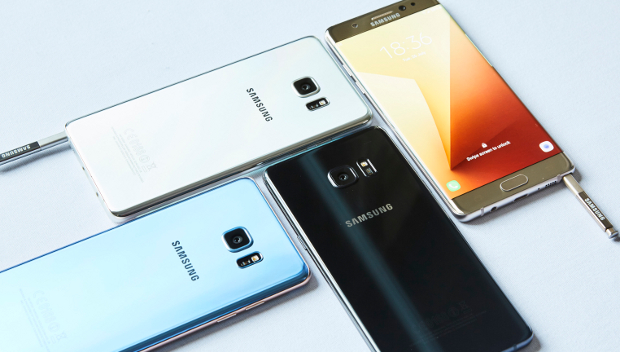There’s a lot to like in Samsung’s new Galaxy Note7, which will ship on 19 August.
The sharp screen is accentuated by a slight curve on the edges that makes the device easy to handle. It has a snappy, 64-bit processor, and it can rock games and virtual reality with the companion Gear VR headset. Samsung’s attention to smaller details makes it a fine device. Here are seven things you need to know:
Many similarities with Galaxy S7 and S7 Edge
The Galaxy Note7 is a large-screen version of the Galaxy S7 and S7 Edge, with a 5.7″ 2560 x 1440-pixel display. The USB-C port is an improvement over S7’s micro-USB 2.0 ports. Common features include a 12MP rear camera, 5MP front camera, 802.11ac Wi-Fi, NFC, Bluetooth and wireless charging. The Note7 is pre-loaded with Android 6.0.1, weighs 169g and is 7.9mm thick. It has 64Gb of internal storage and an SD card slot.
The iris scanner has its own camera
A unique Note7 security feature is the ability to scan the iris as a way to log users into the device. Here’s how it works: Place your eyes in front of the iris scanner – which is an IR camera – located on top of the screen, which will scan your eyes. It will match up the scan against encrypted iris information stored in a secure hardware layer on the phone. Iris scanner works in multiple light settings, but it won’t work with sunglasses, Samsung said.
What chip does your Note 7 have?
In US, China, and Japan, the Galaxy Note7 will have a Qualcomm Snapdragon 820 chipset; in other places (including Ireland), it’ll be Samsung’s Exynos 8 Octa 8890 chip. The Snapdragon 820 has been modulated for cellular networks and spectrum bands in those countries, and US carriers like Verizon prefer Qualcomm’s chips for backward compatibility of CDMA networks. The Samsung Exynos chip works on mobile networks in Asia and Europe.
What chip is better?
Qualcomm’s Snapdragon has a better modem and a slight edge in graphics over Samsung’s Exynos. Regardless, the Note7 delivers booming graphics and runs applications much faster than its predecessors. The LTE data download speeds could reach up to 600Mb/s and upload speeds up to 150Mb/s. Snapdragon is more versatile with support for LTE-U, which allows for faster data transfers over licensed and unlicensed spectrum.
Old peripherals will work with the USB-C port in Note7
The Note7 has a USB-C port, a first in Samsung smartphones. The Galaxy S7 and S7 Edge have micro-USB 2.0 ports, and many peripherals – like portable mobile phone chargers and storage devices – are designed to plug into that port. Those peripherals can be used with Note7 with a micro-USB 2.0 to USB-C connector that Samsung is providing with the new handset.
Note7 will log you into your Samsung-based Windows PC
Like Apple, Samsung wants its hardware devices to work seamlessly. That’s been difficult because Samsung’s devices run on three OSes: Windows in most PCs, Android in mobile devices, and Tizen in wearables. The Note7 shows some results of Samsung’s effort to bridge that gap between devices. Users can swipe a finger on the Note7 fingerprint reader to log into a Windows-based Galaxy TabPro S 2-in-1 tablet/laptop hybrid. Users can also login into a TabPro S by pattern authentication – by drawing specific shapes – on a Note7.
Samsung Flow is different from Windows Hello, a Microsoft feature for biometric authentication to log into laptops, but a Samsung spokesman said the companies are working together to see how the features could be used together.
No clarity if Note7 will support Google’s DayDream
A great add-on to the Note7 is the new Gear VR headset, in which the phablet can be fitted to virtually roam cities, play games, or ski down a mountain slope. Samsung declined to comment if Note7 would work with Google’s emerging DayDream VR platform, which will be available in specific handsets by the end of the year. The Gear VR headset and Note7 could be combined for DayDream, which has minimum hardware requirements of a high-resolution screen, specific sensors, and strong graphics capabilities. Samsung said announcements on DayDream-compatible devices will come at a later date.
IDG News Service





Subscribers 0
Fans 0
Followers 0
Followers